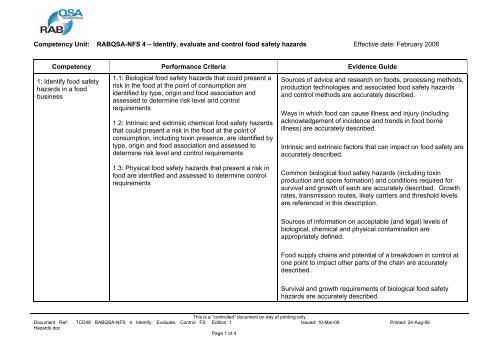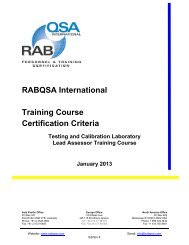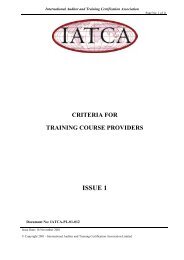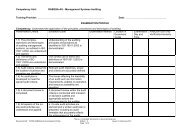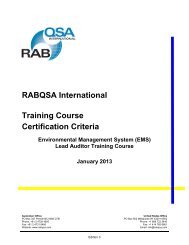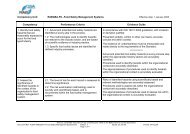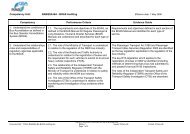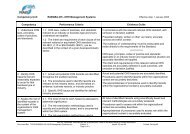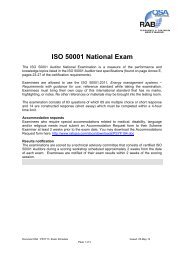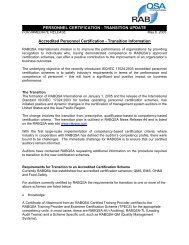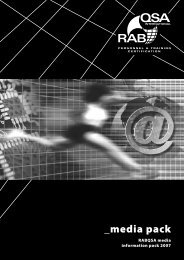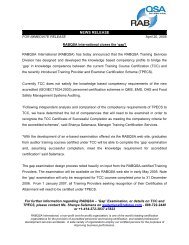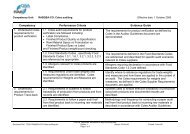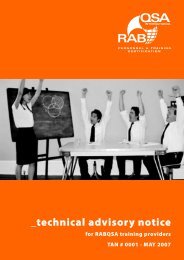RABQSA-NFS 4 â Identify, evaluate and control food safety hazards ...
RABQSA-NFS 4 â Identify, evaluate and control food safety hazards ...
RABQSA-NFS 4 â Identify, evaluate and control food safety hazards ...
Create successful ePaper yourself
Turn your PDF publications into a flip-book with our unique Google optimized e-Paper software.
Competency Unit: <strong>RABQSA</strong>-<strong>NFS</strong> 4 – <strong>Identify</strong>, <strong>evaluate</strong> <strong>and</strong> <strong>control</strong> <strong>food</strong> <strong>safety</strong> <strong>hazards</strong> Effective date: February 2006Competency Performance Criteria Evidence Guide1: <strong>Identify</strong> <strong>food</strong> <strong>safety</strong><strong>hazards</strong> in a <strong>food</strong>business1.1: Biological <strong>food</strong> <strong>safety</strong> <strong>hazards</strong> that could present arisk in the <strong>food</strong> at the point of consumption areidentified by type, origin <strong>and</strong> <strong>food</strong> association <strong>and</strong>assessed to determine risk level <strong>and</strong> <strong>control</strong>requirements1.2: Intrinsic <strong>and</strong> extrinsic chemical <strong>food</strong> <strong>safety</strong> <strong>hazards</strong>that could present a risk in the <strong>food</strong> at the point ofconsumption, including toxin presence, are identified bytype, origin <strong>and</strong> <strong>food</strong> association <strong>and</strong> assessed todetermine risk level <strong>and</strong> <strong>control</strong> requirementsSources of advice <strong>and</strong> research on <strong>food</strong>s, processing methods,production technologies <strong>and</strong> associated <strong>food</strong> <strong>safety</strong> <strong>hazards</strong><strong>and</strong> <strong>control</strong> methods are accurately described.Ways in which <strong>food</strong> can cause illness <strong>and</strong> injury (includingacknowledgement of incidence <strong>and</strong> trends in <strong>food</strong> borneillness) are accurately described.Intrinsic <strong>and</strong> extrinsic factors that can impact on <strong>food</strong> <strong>safety</strong> areaccurately described.1.3: Physical <strong>food</strong> <strong>safety</strong> <strong>hazards</strong> that present a risk in<strong>food</strong> are identified <strong>and</strong> assessed to determine <strong>control</strong>requirementsCommon biological <strong>food</strong> <strong>safety</strong> <strong>hazards</strong> (including toxinproduction <strong>and</strong> spore formation) <strong>and</strong> conditions required forsurvival <strong>and</strong> growth of each are accurately described. Growthrates, transmission routes, likely carriers <strong>and</strong> threshold levelsare referenced in this description.Sources of information on acceptable (<strong>and</strong> legal) levels ofbiological, chemical <strong>and</strong> physical contamination areappropriately defined.Food supply chains <strong>and</strong> potential of a breakdown in <strong>control</strong> atone point to impact other parts of the chain are accuratelydescribed.Survival <strong>and</strong> growth requirements of biological <strong>food</strong> <strong>safety</strong><strong>hazards</strong> are accurately described.This is a “<strong>control</strong>led” document on day of printing only.Document Ref: TCD48 <strong>RABQSA</strong>-<strong>NFS</strong> 4 <strong>Identify</strong>, Evaluate, Control FS Edition: 1 Issued: 10-Mar-06 Printed: 24-Aug-06Hazards.docPage 1 of 4
Competency Unit: <strong>RABQSA</strong>-<strong>NFS</strong> 4 – <strong>Identify</strong>, <strong>evaluate</strong> <strong>and</strong> <strong>control</strong> <strong>food</strong> <strong>safety</strong> <strong>hazards</strong> Effective date: February 2006Competency Performance Criteria Evidence GuideCommon allergenic substances as described by the FoodSt<strong>and</strong>ards Code (<strong>and</strong> may be additionally defined by systemowners) are appropriately referenced.Relevant legislation, codes of practice <strong>and</strong> technical st<strong>and</strong>ardsare accurately describedBiological, chemical <strong>and</strong> physical <strong>food</strong> <strong>safety</strong> <strong>hazards</strong> areaccurately identified.2. Control <strong>food</strong> <strong>safety</strong><strong>hazards</strong> in a <strong>food</strong>business2.1: Processing <strong>hazards</strong> <strong>and</strong> related <strong>control</strong> measures<strong>and</strong> critical limits, monitoring <strong>and</strong> recordingrequirements are established <strong>and</strong> validated to eliminateor reduce <strong>food</strong> <strong>safety</strong> <strong>hazards</strong> to acceptable levels2.2: Food storage <strong>and</strong> h<strong>and</strong>ling requirementsnecessary to eliminate or reduce <strong>food</strong> <strong>safety</strong> <strong>hazards</strong>are determined2.3: Personal hygiene practices required to eliminate orreduce <strong>food</strong> <strong>safety</strong> <strong>hazards</strong> are established2.4: Cleaning <strong>and</strong> sanitation, housekeeping <strong>and</strong> pest<strong>control</strong> practices <strong>and</strong> procedures required to prevent orreduce <strong>food</strong> <strong>safety</strong> <strong>hazards</strong> are established2.5: Other pre-requisite programs are developed toeliminate or reduce <strong>food</strong> <strong>safety</strong> <strong>hazards</strong> to acceptableCommon <strong>control</strong> methods necessary to eliminate or reduce therisk of <strong>food</strong> borne illness to acceptable levels for each commonpathogen are described. This should include but not be limitedto the role of <strong>food</strong> storage, temperature <strong>control</strong>, preservation<strong>and</strong> process methods, traceability, product shelf life, cleaning<strong>and</strong> sanitation <strong>and</strong> pest <strong>control</strong>.Methods to detect <strong>and</strong> minimize the risk of <strong>food</strong> contaminationby personal carriers (including convalescent <strong>and</strong> symptomlesscarriers) <strong>and</strong> related minimum legal illness reportingrequirements <strong>and</strong> personal hygiene procedures are described.The roles of microbiological sampling, swabbing <strong>and</strong> testing inassessing the presence of biological contamination aredescribed.This is a “<strong>control</strong>led” document on day of printing only.Document Ref: TCD48 <strong>RABQSA</strong>-<strong>NFS</strong> 4 <strong>Identify</strong>, Evaluate, Control FS Edition: 1 Issued: 10-Mar-06 Printed: 24-Aug-06Hazards.docPage 2 of 4
Competency Unit: <strong>RABQSA</strong>-<strong>NFS</strong> 4 – <strong>Identify</strong>, <strong>evaluate</strong> <strong>and</strong> <strong>control</strong> <strong>food</strong> <strong>safety</strong> <strong>hazards</strong> Effective date: February 2006Competency Performance Criteria Evidence GuidelevelsMethods to determine the appropriateness <strong>and</strong> effectiveness ofthe <strong>control</strong> measures <strong>and</strong> critical limits are described. Thisshould include identifying the effect of <strong>control</strong> measures on theidentified <strong>food</strong> <strong>safety</strong> hazard; method <strong>and</strong> feasibility ofmonitoring; the relationship to other <strong>control</strong> measures <strong>and</strong> theseverity of consequences <strong>and</strong> required corrective action in theevent of failure of <strong>control</strong>Types <strong>and</strong> causes of acute <strong>and</strong> chronic chemical <strong>food</strong> borneillness are described.The <strong>food</strong> <strong>safety</strong> <strong>and</strong> legal impacts of chemical contaminationincluding residual agricultural <strong>and</strong> environmental chemicals;residual industrial (including cleaning) chemicals; <strong>and</strong> chemicalcontamination as a result of packaging methods <strong>and</strong> materialsare described.Physical <strong>hazards</strong> that pose a <strong>food</strong> <strong>safety</strong> risk are described.Common <strong>control</strong> methods to eliminate or reduce the risk ofchemical or physical <strong>food</strong> borne illness to acceptable levels foreach common form of chemical <strong>and</strong> physical <strong>food</strong> <strong>safety</strong>hazard are described. This should include:• Chemicals that pose a <strong>food</strong> <strong>safety</strong> risk• Common <strong>food</strong> allergens• Physical <strong>hazards</strong>This is a “<strong>control</strong>led” document on day of printing only.Document Ref: TCD48 <strong>RABQSA</strong>-<strong>NFS</strong> 4 <strong>Identify</strong>, Evaluate, Control FS Edition: 1 Issued: 10-Mar-06 Printed: 24-Aug-06Hazards.docPage 3 of 4
Competency Unit: <strong>RABQSA</strong>-<strong>NFS</strong> 4 – <strong>Identify</strong>, <strong>evaluate</strong> <strong>and</strong> <strong>control</strong> <strong>food</strong> <strong>safety</strong> <strong>hazards</strong> Effective date: February 2006Competency Performance Criteria Evidence GuideThe role <strong>and</strong> requirement of pre-requisite programs <strong>and</strong>procedures to eliminate, prevent or reduce biological, chemical<strong>and</strong> physical <strong>food</strong> <strong>safety</strong> <strong>hazards</strong> to acceptable levels aredescribed.Methods for determining critical <strong>control</strong> points (CCP) <strong>and</strong>critical limits for identified <strong>hazards</strong> are described.Methods to establish the required procedures, systems <strong>and</strong>records to monitor critical <strong>control</strong> points in order to demonstratethat the CCP is in <strong>control</strong> are described.Corrective actions <strong>and</strong> corrections to be taken when criticallimits are not achieved are described.This is a “<strong>control</strong>led” document on day of printing only.Document Ref: TCD48 <strong>RABQSA</strong>-<strong>NFS</strong> 4 <strong>Identify</strong>, Evaluate, Control FS Edition: 1 Issued: 10-Mar-06 Printed: 24-Aug-06Hazards.docPage 4 of 4


